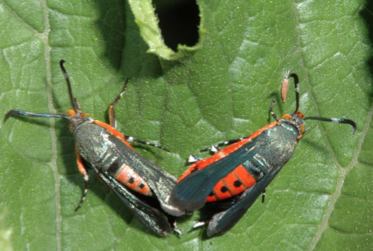Trap Cropping — A Bait and Switch Strategy
By Janet Scheren, Fairfax Master Gardener

Squash Vine Borer
Keeping your soil free of pesticides and other toxic chemicals is one of the best ways to promote healthy soil and grow more abundant plants, but you’ll need strategies to keep nuisance insect pests at bay. Companion planting, mixing crops throughout the garden to avoid concentrations of the same plant or plant family, rotating crops, and encouraging beneficial insects are four strategies that not only protect valuable crops from pests but add to the diversity and beauty of your garden. Another highly effective, yet often overlooked option, is the use of trap crops. While companion plants are generally selected to repel pests or hide the scent of your crop, trap crops take essentially the opposite approach. They attract pests to themselves and away from the plants you are trying to protect. Thus, a trap crop is essentially a sacrificial plant that serves as a decoy.
Trap crops are often selected because they are even more desirable to the pest than the plant you are trying to shield. Use timing and distance to enhance the effectiveness of this strategy: Because trap crops are most effective when they begin to flower or seed, you’ll want to be sure to plant them before your main crop. For most trap crops, this will be two to three weeks in advance. Additionally, you’ll want to keep trap crops at a distance from the main crops — typically 8 to 12 feet (2 to 4 m).
While these are sacrificial plants, they need to be treated with the same care and attention as your main crops to serve as an attractive target to pests. Check your trap crops at least once a day to look for signs of eggs, larvae, caterpillars or adult pests. If you catch pests early enough, you can remove them in their early stages so the trap crops can continue to serve their purpose — and may also provide a harvest. More severe infestations may require you to remove and burn the trap crop or selectively use pesticides, always the last resort.
Some examples of pests and their trap and target crops include the following:
Stink Bugs and Leaf-Footed Bugs
Cherry tomatoes are a big attraction for stink bugs and leaf-footed bugs. A few cherry tomatoes planted away from your main tomato crop will often draw the majority of pests to them leaving the others pest free. Okra is also highly attractive to these two pests, so in addition to being an attractive member of the hibiscus family, it can serve to lure destructive bugs. Other attractive plants that can fill this role are sorghum and sunflowers. These trap crops can help keep green beans, tomatoes, okra and peppers, to name a few, free of damage from stink bugs and leaf-footed bugs.
Cucumber Beetles, Squash Vine Borers, and Squash Bugs
Blue hubbard squash is a magnet for cucumber beetles, squash vine borers and squash bugs. It is often used as a trap crop to help protect cucurbits — from zucchini to cucumbers, pumpkins and other winter squashes such as butternut and Delicta squash. Cucumber beetles can also infest roses. Adult cucumber beetles as well as larva feed on plants. Adults will attack the tender young growth of stems and leaves as well as the buds and petals of mature specimens. In addition to chewing damage, they also spread disease, typically bacterial wilt and cucumber mosaic virus.
Thrips
In addition to providing strong fragrance to deter many pests, marigolds and blue carpet petunias can also serve as a trap crop to draw thrips. These insects often infect tomatoes and peas.

Flea beetles
Tomato Horned Worms
Nicotiana is effective in diverting tomato horned worms and helping to keep them off your tomato plants.
Flea Beetles
Radishes and arugula are effective trap crops to protect other brassicas from flea beetles.
Nematodes
Radishes and yellow mustard can serve as a trap crop to deter nematodes from attacking beet roots.
Resources
• Trap Cropping to Control Cucumber Beetles and Squash Bugs in Cucurbit Crops, Jaime C. Pinero,
Lincoln University Cooperative Extension, Jefferson City, Missouri
• Trap Cropping for Small-Market Vegetable Growers, Circular 1118, Bob Westerfield and S. Kris Braman,
University of Georgia Extension
• Trap Crops: A Promising Alternative for Sugar Beet Nematode Control, David W. Koch, et al,
University of Wyoming Extension
• Trap cropping: A simple, effective, and affordable Integrated Pest Management strategy …,
Integrated Pest Management, University of Missouri